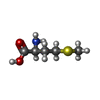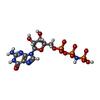+Search query
-Structure paper
| Title | Cryo-EM study of an archaeal 30S initiation complex gives insights into evolution of translation initiation. |
|---|---|
| Journal, issue, pages | Commun Biol, Vol. 3, Issue 1, Page 58, Year 2020 |
| Publish date | Feb 6, 2020 |
 Authors Authors | Pierre-Damien Coureux / Christine Lazennec-Schurdevin / Sophie Bourcier / Yves Mechulam / Emmanuelle Schmitt /  |
| PubMed Abstract | Archaeal translation initiation occurs within a macromolecular complex containing the small ribosomal subunit (30S) bound to mRNA, initiation factors aIF1, aIF1A and the ternary complex aIF2:GDPNP: ...Archaeal translation initiation occurs within a macromolecular complex containing the small ribosomal subunit (30S) bound to mRNA, initiation factors aIF1, aIF1A and the ternary complex aIF2:GDPNP:Met-tRNA. Here, we determine the cryo-EM structure of a 30S:mRNA:aIF1A:aIF2:GTP:Met-tRNA complex from Pyrococcus abyssi at 3.2 Å resolution. It highlights archaeal features in ribosomal proteins and rRNA modifications. We find an aS21 protein, at the location of eS21 in eukaryotic ribosomes. Moreover, we identify an N-terminal extension of archaeal eL41 contacting the P site. We characterize 34 N-acetylcytidines distributed throughout 16S rRNA, likely contributing to hyperthermostability. Without aIF1, the 30S head is stabilized and initiator tRNA is tightly bound to the P site. A network of interactions involving tRNA, mRNA, rRNA modified nucleotides and C-terminal tails of uS9, uS13 and uS19 is observed. Universal features and domain-specific idiosyncrasies of translation initiation are discussed in light of ribosomal structures from representatives of each domain of life. |
 External links External links |  Commun Biol / Commun Biol /  PubMed:32029867 / PubMed:32029867 /  PubMed Central PubMed Central |
| Methods | EM (single particle) |
| Resolution | 3.1 - 4.2 Å |
| Structure data | EMDB-10320: IC2A cryo-EM map of a full archaeal ribosomal translation initiation complex devoid of aIF1 in P. abyssi EMDB-10322: IC2B cryo-EM structure of a full archaeal ribosomal translation initiation complex devoid of aIF1 in P. abyssi EMDB-10323: IC2 body cryo-EM structure of a full archaeal ribosomal translation initiation complex devoid of aIF1 in P. abyssi EMDB-10324, PDB-6swe: |
| Chemicals |  ChemComp-MG:  ChemComp-ZN:  ChemComp-MET:  ChemComp-GNP:  ChemComp-HOH: |
| Source |
|
 Keywords Keywords | RIBOSOME / Translation initiation / cryo-EM / tRNA / evolution / archaea / rRNA modifications |
 Movie
Movie Controller
Controller Structure viewers
Structure viewers About Yorodumi Papers
About Yorodumi Papers












 pyrococcus abyssi ge5 (archaea)
pyrococcus abyssi ge5 (archaea)
